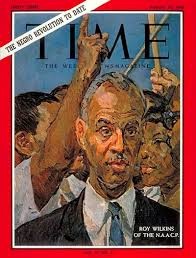

Roy Wilkins was born on August 30, 1901, in St. Louis, Missouri , Roy Wilkins worked as a journalist/activist before becoming involved with the NAACP, succeeding Walter White as its leader in the 1950s. Wilkins was a major figure of the Civil Rights Movement and was involved in an array of key events, including the Brown v. Board of Education ruling and the March on Washington. He was a prominent civil rights activist in the United States from the 1930s to the 1970s. Wilkins’ most notable role was in his leadership of the National Association for the Advancement of Colored People (NAACP).
His mother died when he was four years old, after which Wilkins and his siblings were raised by an aunt and uncle in St. Paul, Minnesota. Wilkins graduated from the University of Minnesota with a degree in sociology in 1923. In 1929, he married social worker Aminda “Minnie” Badeau; the couple had no children of their own. The couple did raise the two children of Hazel Wilkins-Colton, a writer out of Philadelphia, Pennsylvania. The Wilkins were members of the AME Church and he joined Dr. Martin Luther King, Jr and A. Phillip Randolph at the 1960 General Conference in LA to reinforce the AME Church’s role in the freedom struggle.
After graduation, Wilkins worked as a journalist at The Minnesota Daily and became editor of The Appeal, an African-American newspaper. After he graduated he became the editor of the The Call.
Between 1931 and 1934, Wilkins was assistant NAACP secretary under Walter Francis White. When W. E. B. Du Bois left the organization in 1934, he replaced him as editor of The Crisis, the official magazine of the NAACP, which he ran for a decade and a half . Working with the group’s strong anti-lynching efforts, Wilkins also went undercover to observe and take part in the horrible job conditions African Americans toiled under as part of a federally funded river initiative in Mississippi. Wilkins’s ensuing Mississippi Slave Labor report was instrumental in producing change for the workers. From 1949 to 1950 Wilkins chaired the National Emergency Civil Rights Mobilization, which comprised more than 100 local and national groups. Later on, he was one of the key players in getting the 1954 Brown v. Board of Education case to the Supreme Court, whose ruling declared public school segregation illegal. With White’s passing in 1955, Wilkins was voted in as the NAACP’s executive secretary, later known as executive director and served until 1977 (22 years).
Wilkins was also a member of Omega Psi Phi, a fraternity with a civil rights focus, and one of the intercollegiate Greek-letter fraternities established for African Americans.
In 1964, he was awarded the Spingarn Medal from the NAACP. In 1967, Wilkins was awarded the Presidential Medal of Freedom by Lyndon Johnson. During his tenure, the NAACP played a pivotal role in leading the nation into the Civil Rights movement and spearheaded the efforts that led to significant civil rights victories, including Brown v. Board of Education, the Civil Rights Act of 1964, and the Voting Rights Act of 1965.
In 1968, Wilkins also served as chair of the U.S. delegation to the International Conference on Human Rights.
A USPS stamp was issued with his image in 2001.
Wilkins died on September 8, 1981, in New York City, due to kidney failure and heart issues. He received many awards and honors during his lifetime; books on him include his 1982 posthumously published autobiography, Standing Fast, as well as 2005’s Roy Wilkins: Leader of the NAACP by Calvin Craig Miller. Wilkins’s alma mater, the University of Minnesota, created the Roy Wilkins Center for Human Relations and Human Justice.
